On the Procedure of Draught Rate Assessment in Indoor Spaces
Abstract
Featured Application
Abstract
1. Introduction
2. Problem Formulation
2.1. Description of the Room Geometry
2.2. Description of Measurement Technique and Equipment
2.3. Computational Aspects
2.3.1. Unsteady RANS (URANS) Simulations for Computational Fluid Dynamics (CFD) Validation
2.3.2. RANS Simulations
3. Measurement Data
3.1. Airflow near the Fan Coil
3.2. Airflow in the Room
4. URANS Data on Airflow
4.1. Global Unsteady Airflow Pattern
4.2. Comparison of CFD and Experimental Data
5. Draught Rate Evaluation Discussion
5.1. RANS-Based Draught Rate (DR) Evaluation
5.2. URANS-Based DR Evaluation
5.3. DR Evaluation Based on the Measurement Data
5.4. Categorization of the Classroom Environment Based on Measured DR
6. Conclusions
Author Contributions
Funding
Acknowledgments
Conflicts of Interest
References
- Sakellaris, I.; Saraga, D.; Mandin, C.; de Kluizenaar, Y.; Fossati, S.; Spinazzè, A.; Cattaneo, A.; Szigeti, T.; Mihucz, V.; de Oliveira Fernandes, E.; et al. Personal Control of the Indoor Environment in Offices: Relations with Building Characteristics, Influence on Occupant Perception and Reported Symptoms Related to the Building—The Officair Project. Appl. Sci. 2019, 9, 3227. [Google Scholar] [CrossRef]
- Branco, P.T.B.S.; Alvim-Ferraz, M.C.M.; Martins, F.G.; Sousa, S.I.V. Quantifying indoor air quality determinants in urban and rural nursery and primary schools. Environ. Res. 2019, 176, 108534. [Google Scholar] [CrossRef] [PubMed]
- Chen, Y.; Chen, B. The Combined Effect of Indoor Air Quality and Socioeconomic Factors on Health in Northeast China. Appl. Sci. 2019, 10, 2827. [Google Scholar] [CrossRef]
- Olesen, B.; Bluyssen, P.; Roulet, C.A. Ventilation and Indoor Environmental Quality; Taylor & Francis: Abingdon, UK, 2007; pp. 62–105. [Google Scholar]
- van Dijken, F.; van Bronswijk, J.E.M.H.; Sundell, J. Indoor environment in Dutch primary schools and health of the pupils. Build. Res. Inform. 2006, 34, 437–446. [Google Scholar] [CrossRef]
- Holcomb, L.C.; Pedelty, J.F. Comparison of employee upper respiratory absenteeism costs with costs associated with improved ventilation. ASHRAE Trans. 1994, 100, 914–921. [Google Scholar]
- Schreuder, E.; van Heel, L.; Goedhart, R.; Dusseldorp, E.; Schraagen, J.M.; Burdorf, A. Effects of newly designed hospital buildings on staff perceptions: A pre-post study to validate design decisions. HERD Health Environ. Res. Des. J. 2015, 8, 77–97. [Google Scholar] [CrossRef]
- Bode, F.I.; Croitoru, C.V.; Dogeanu, A.M.; Nastase, I. Thermal comfort and IEQ assessment of an under-floor air distribution system. In Proceedings of the BS2013 Conference, Chambéry, France, 26–28 August 2013; pp. 2334–23399. [Google Scholar]
- Dhalluin, A.; Limam, K. Comparison of natural and hybrid ventilation strategies used in classrooms in terms of indoor environmental quality, comfort and energy savings. Indoor Built Environ. 2014, 23, 527–542. [Google Scholar] [CrossRef]
- Rohdin, P.; Molin, A.; Moshfegh, B. Experiences from nine passive houses in Sweden–Indoor thermal environment and energy use. Build. Environ. 2014, 71, 176–185. [Google Scholar] [CrossRef]
- ISO 7730. Ergonomics of the Thermal Environment. Analytical Determination and Interpretation of Thermal Comfort Using Calculation of the PMV and PPD Indices and Local Thermal Comfort Criteria; International Organization for Standardization: Geneva, Switzerland, 2005. [Google Scholar]
- Gendelis, S.; Jakovičs, A.; Ratnieks, J. Thermal comfort condition assessment in test buildings with different heating/cooling systems and wall envelopes. Energy Procedia 2017, 132, 153–158. [Google Scholar] [CrossRef]
- Simone, A.; Della Crociata, S.; Martellotta, F. The influence of clothing distribution and local discomfort on the assessment of global thermal comfort. Build. Environ. 2013, 59, 644–653. [Google Scholar] [CrossRef]
- Mumovic, D.; Palmer, J.; Davies, M.; Orme, M.; Ridley, I.; Oreszczyn, T.; Judd, C.; Critchlow, R.; Medina, H.A.; Pilmoor, G.; et al. Winter indoor air quality, thermal comfort and acoustic performance of newly built secondary schools in England. Build. Environ. 2009, 44, 1466–1477. [Google Scholar] [CrossRef]
- Kiil, M.; Mikola, A.; Thalfeldt, M.; Kurnitski, J. Thermal comfort and draught assessment in a modern open office building in Tallinn. In E3S Web of Conferences; EDP Sciences: Les Ulis, France, 2019; Volume 111. [Google Scholar]
- Kiil, M.; Simson, R.; Thalfeldt, M.; Kurnitski, J. A comparative study on cooling period thermal comfort assessment in modern open office landscape in Estonia. Atmosphere 2020, 11, 127. [Google Scholar] [CrossRef]
- Koper, P.; Lipska, B.; Michnol, W. Assessment of thermal comfort in an indoor swimming pool making use of the numerical prediction CFD. Archit. Civ. Eng. Environ. 2010, 3, 95–104. [Google Scholar]
- Deng, X.; Tan, Z. Numerical analysis of local thermal comfort in a plan office under natural ventilation. Indoor Built Environ. 2019, 1420326X19866497. [Google Scholar] [CrossRef]
- Fanger, P.O.; Christensen, N.K. Perception of draught in ventilated spaces. Ergonomics 1986, 29, 215–235. [Google Scholar] [CrossRef]
- Griefahn, B.; Künemund, C.; Gehring, U. The impact of draught related to air velocity, air temperature and workload. Appl. Ergon. 2001, 32, 407–417. [Google Scholar] [CrossRef]
- Hens, H.S. Thermal comfort in office buildings: Two case studies commented. Build. Environ. 2009, 44, 1399–1408. [Google Scholar] [CrossRef]
- Olesen, B.; D’Ambrosio-Alfano, F.R.; Parsons, K.C.; Palella, B.I. The history of international standardization for the ergonomics of the thermal environment. In Proceedings of the 9th International Windsor Conference, Cumberland Lodge, Windsor, UK, 7–10 April 2016; pp. 7–10. [Google Scholar]
- Lampret, Ž.; Krese, G.; Butala, V.; Prek, M. Impact of airflow temperature fluctuations on the perception of draught. Energy Build. 2018, 179, 112–120. [Google Scholar] [CrossRef]
- Abid, H.; Baklouti, I.; Driss, Z.; Bessrour, J. Experimental and numerical investigation of the Reynolds number effect on indoor airflow characteristics. Adv. Build. Energy Res. 2019, 1–26. [Google Scholar] [CrossRef]
- Fanger, P.O.; Melikov, A.K.; Hanzawa, H.; Ring, J. Air turbulence and sensation of draught. Energy Build. 1988, 12, 21–39. [Google Scholar] [CrossRef]
- Pinto, D.; Rocha, A.; Simões, M.L.; Almeida, R.M.; Barreira, E.; Pereira, P.F.; Ramos, N.M.; Martins, J.P. An innovative approach to evaluate local thermal discomfort due to draught in semi-outdoor spaces. Energy Build. 2019, 203, 109416. [Google Scholar] [CrossRef]
- American Society of Heating; Refrigerating and Air-Conditioning Engineers. Thermal Environmental Conditions for Human Occupancy: ANSI/ASHRAE Standard 55-2017; ASHRAE: Peachtree Corners, GA, USA, 2017. [Google Scholar]
- EU Standard 16798-1. Energy Performance of Buildings—Ventilation for Buildings—Part 1; International Organization for Standardization: Geneva, Switzerland, 2019. [Google Scholar]
- Zhai, Z.J.; Zhang, Z.; Zhang, W.; Chen, Q.Y. Evaluation of various turbulence models in predicting airflow and turbulence in enclosed environments by CFD: Part 1—Summary of prevalent turbulence models. HVAC R Res. 2007, 13, 853–870. [Google Scholar] [CrossRef]
- Thool, S.B.; Sinha, S.L. Simulation of room airflow using CFD and validation with experimental results. Int. J. Eng. Sci. Technol. 2014, 6, 192. [Google Scholar]
- Risberg, D.; Vesterlund, M.; Westerlund, L.; Dahl, J. CFD simulation and evaluation of different heating systems installed in low energy building located in sub-arctic climate. Build. Environ. 2015, 89, 160–169. [Google Scholar] [CrossRef]
- Hirsch, C.; Tartinville, B. Reynolds-Averaged Navier-Stokes modelling for industrial applications and some challenging issues. Int. J. Comput. Fluid Dyn. 2009, 23, 295–303. [Google Scholar] [CrossRef]
- Koskela, H.; Heikkinen, J. Calculation of thermal comfort from CFD-simulation results. In Proceedings of the International Conference on Indoor Air Quality and Climate, Monterey, CA, USA, 30 June–5 July 2002; Volume 3, pp. 712–717. [Google Scholar]
- Li, Y.; Nielsen, P.V. CFD and ventilation research. Indoor Air 2011, 21, 442–453. [Google Scholar] [CrossRef]
- Ivanov, N.G.; Zasimova, M.A. Mean air velocity correction for thermal comfort calculation: Assessment of velocity-to-speed conversion procedures using Large Eddy Simulation data. J. Phys. Conf. Ser. 2018, 1135, 012106. [Google Scholar] [CrossRef]
- Markov, D. Practical evaluation of the thermal comfort parameters. In Proceedings of the First Annual International Course: Ventilation and Indoor climate, Pamporovo, Bulgaria, 21–25 October 2002. [Google Scholar]
- Ivanov, N.; Zasimova, M.; Smirnov, E.; Abramov, A.; Markov, D.; Stankov, P. Unsteady RANS Simulation of Air Distribution in a Ventilated Classroom with Numerous Jets. E3S Web Conf. 2019, 111, 02010. [Google Scholar] [CrossRef]
- ISO 7726. Ergonomics of the Thermal Environment—Instruments for Measuring Physical Quantities; International Organization for Standardization: Geneva, Switzerland, 1998. [Google Scholar]
- Kosutova, K.; Van Hoof, T.; Vanderwel, C.; Bloocken, B.; Hensen, J. Cross-ventilation in a generic isolated building equipped with louvers: Wind-tunnel experiments and CFD simulations. Build. Environ. 2019, 154, 263–280. [Google Scholar] [CrossRef]
- Ivanov, N.G.; Zasimova, M.A.; Smirnov, E.M.; Markov, D. Evaluation of mean velocity and mean speed for test ventilated room from RANS and LES CFD modeling. E3S Web Conf. 2019, 85, 02004. [Google Scholar] [CrossRef]
- Mijorski, S.G.; Markov, D.G.; Pichurov, G.T.; Stankov, P.; Ivanov, N.G.; Simova, I.S. CFD based design of a ventilated space. In IOP Conference Series: Materials Science and Engineering; IOP Publishing: Bristol, UK, 2019; Volume 618, p. 012049. [Google Scholar]
- Koskela, H.; Heikkinen, J.; Niemela, R.; Hautalampi, T. Turbulence correction for thermal comfort calculation. Build. Environ. 2001, 36, 247–255. [Google Scholar] [CrossRef]
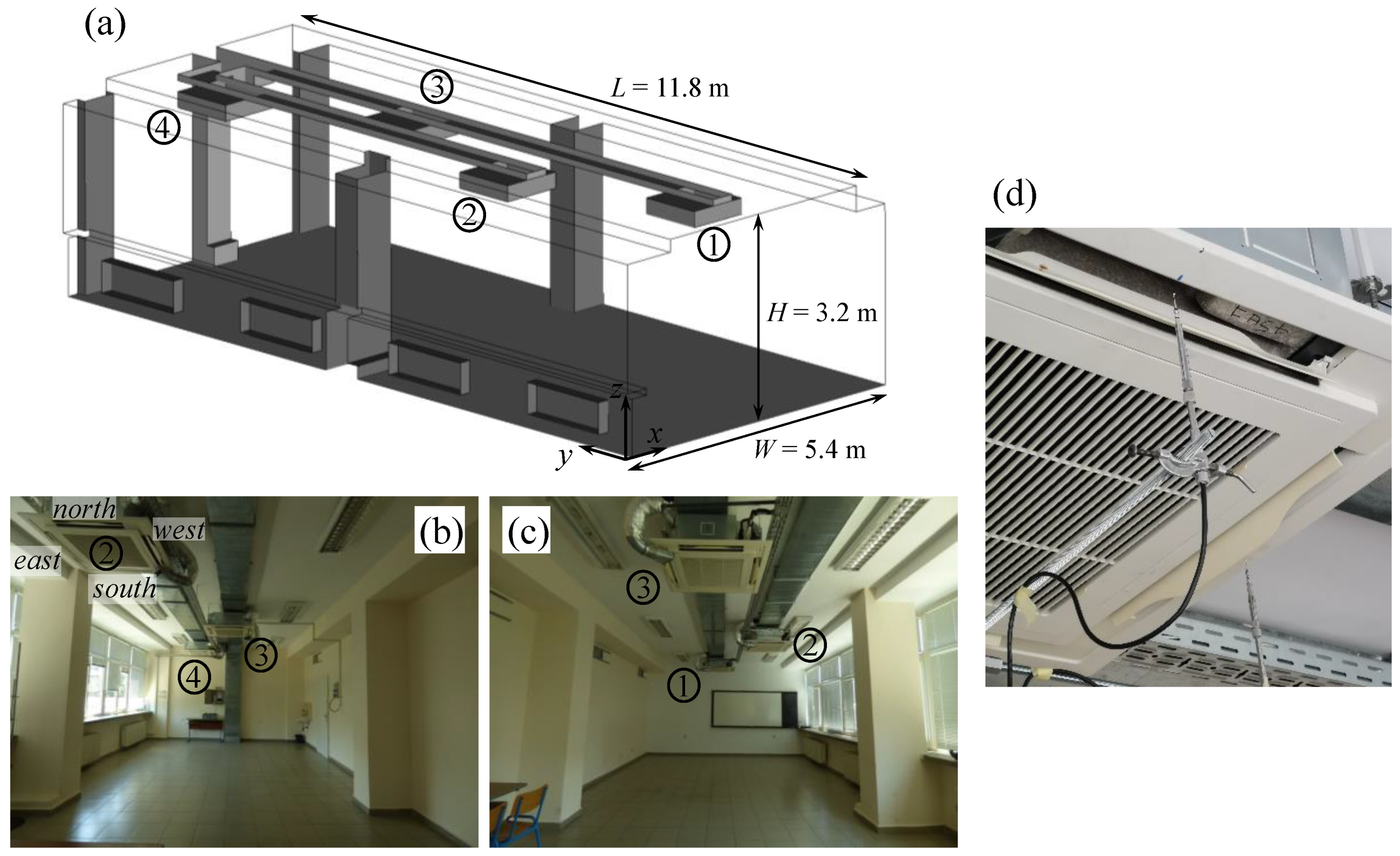



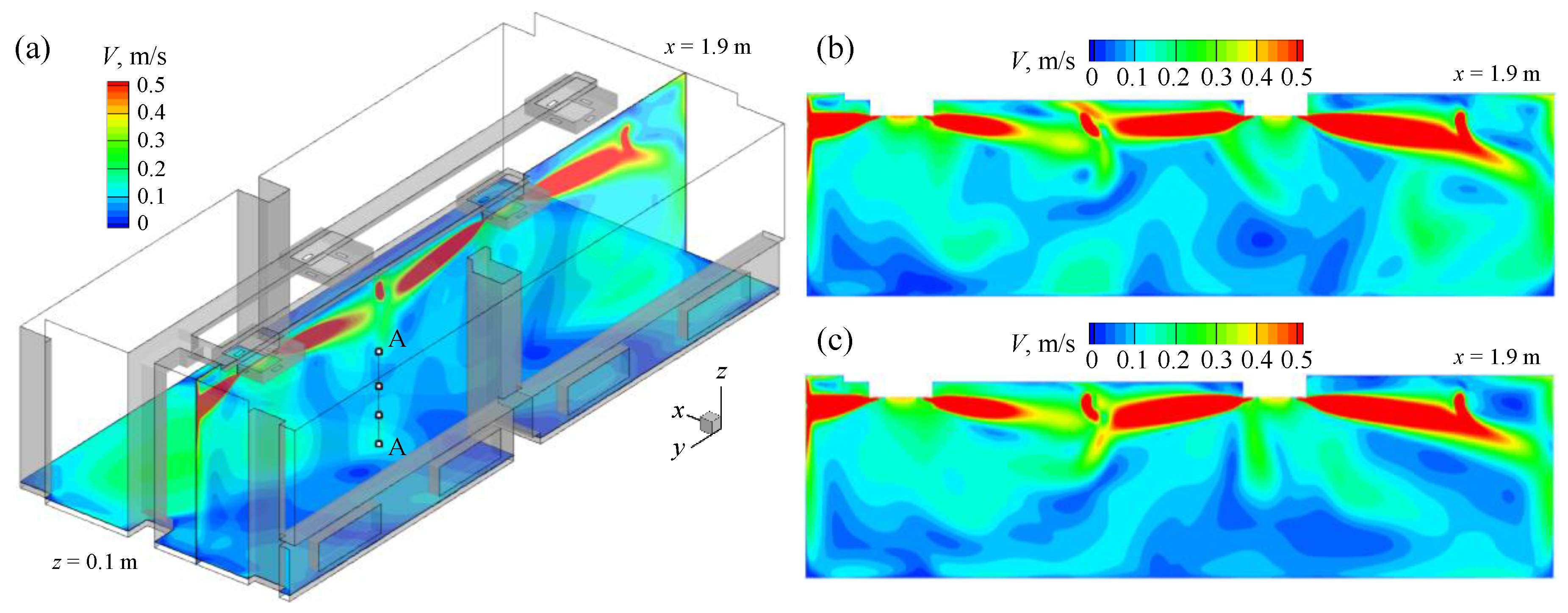
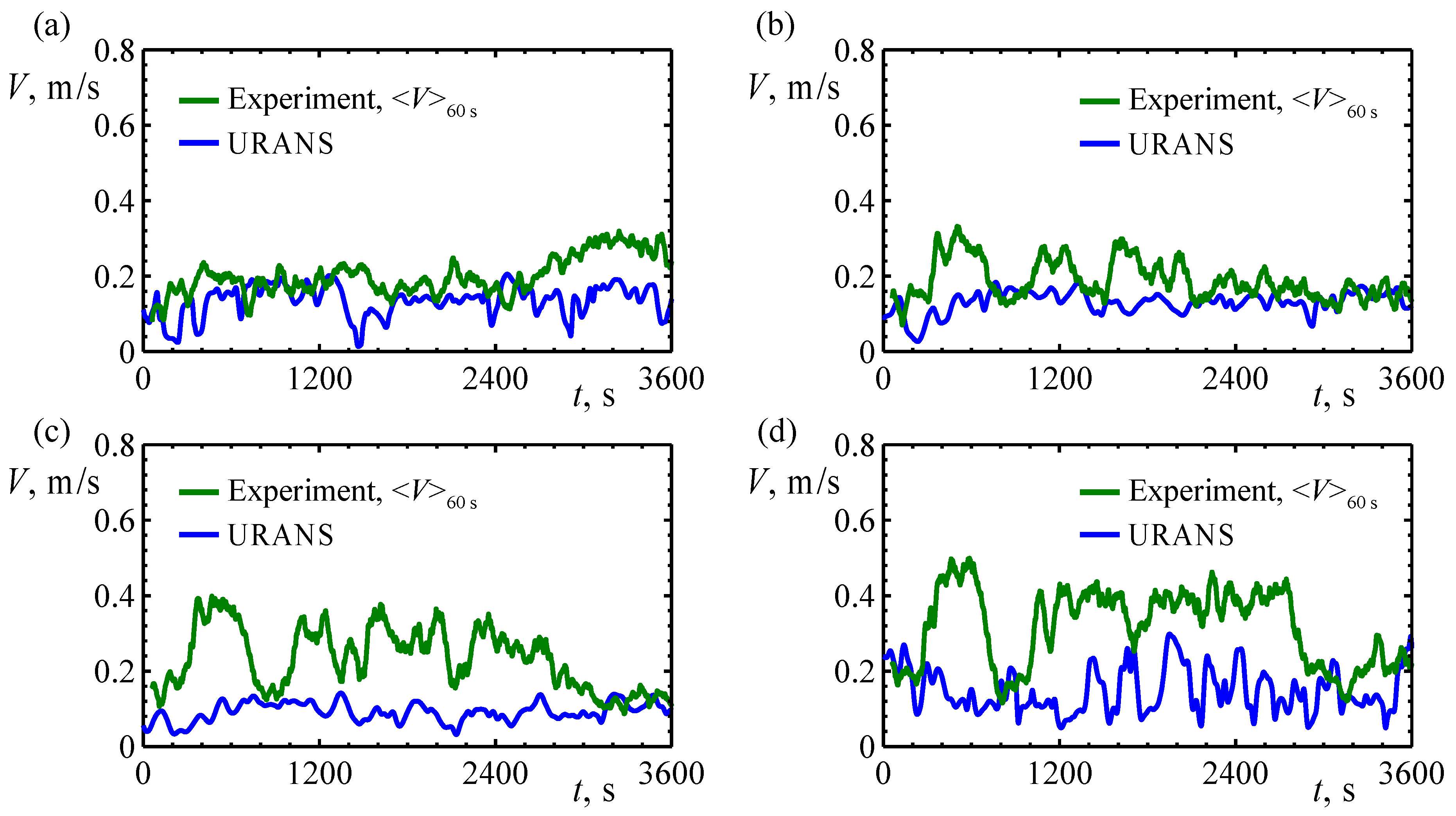
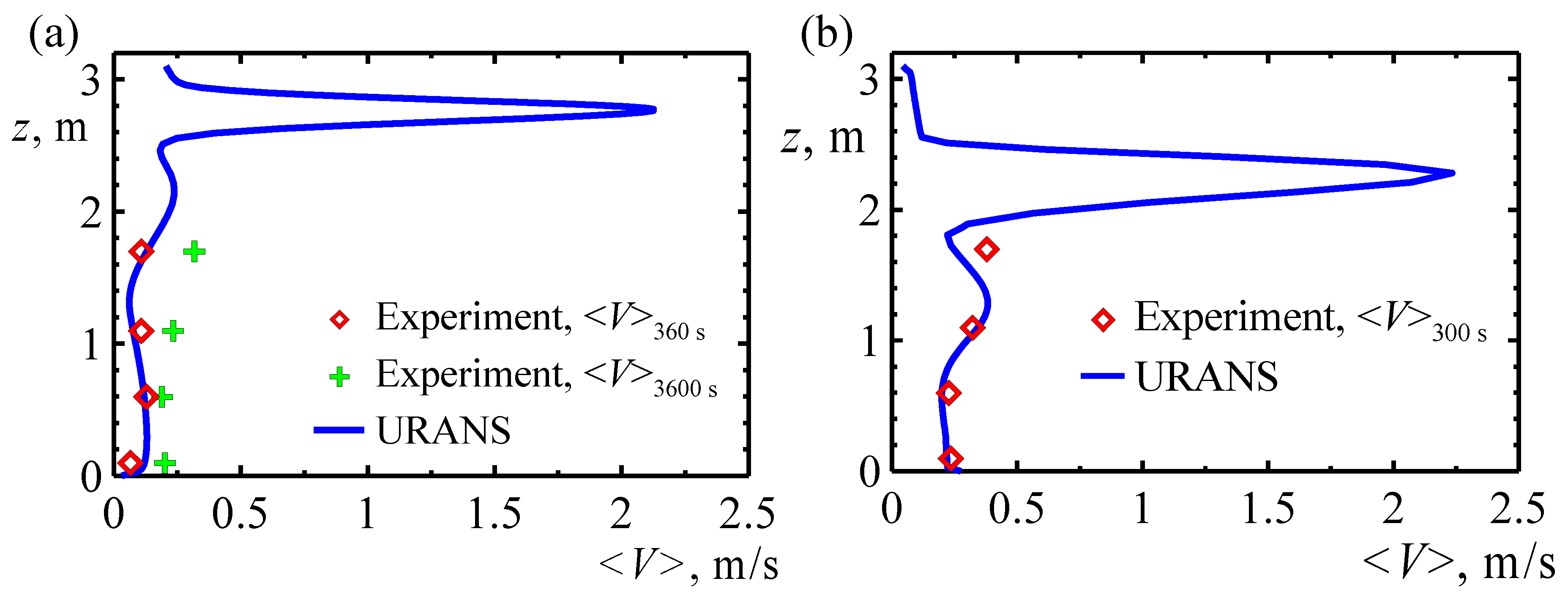
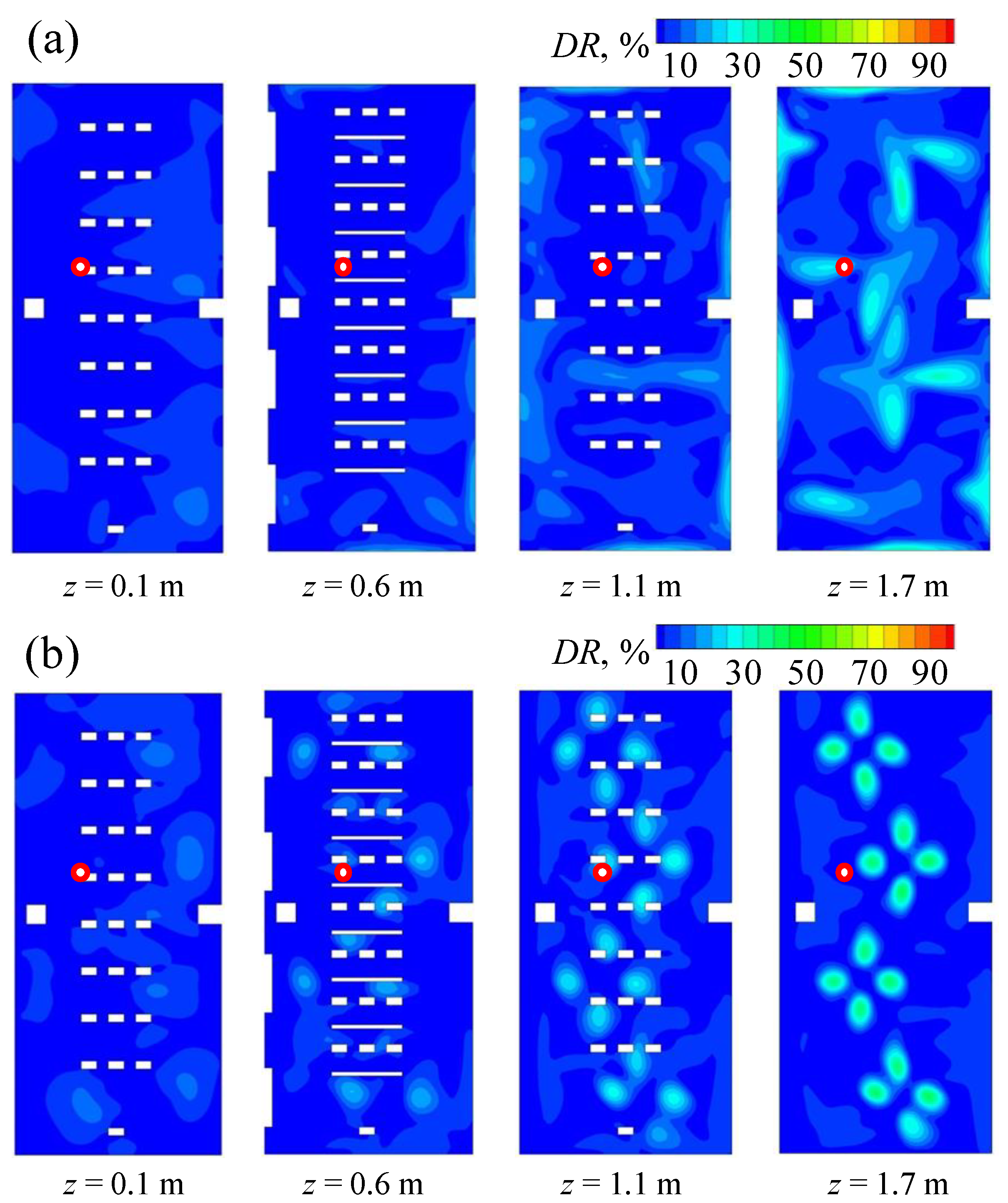
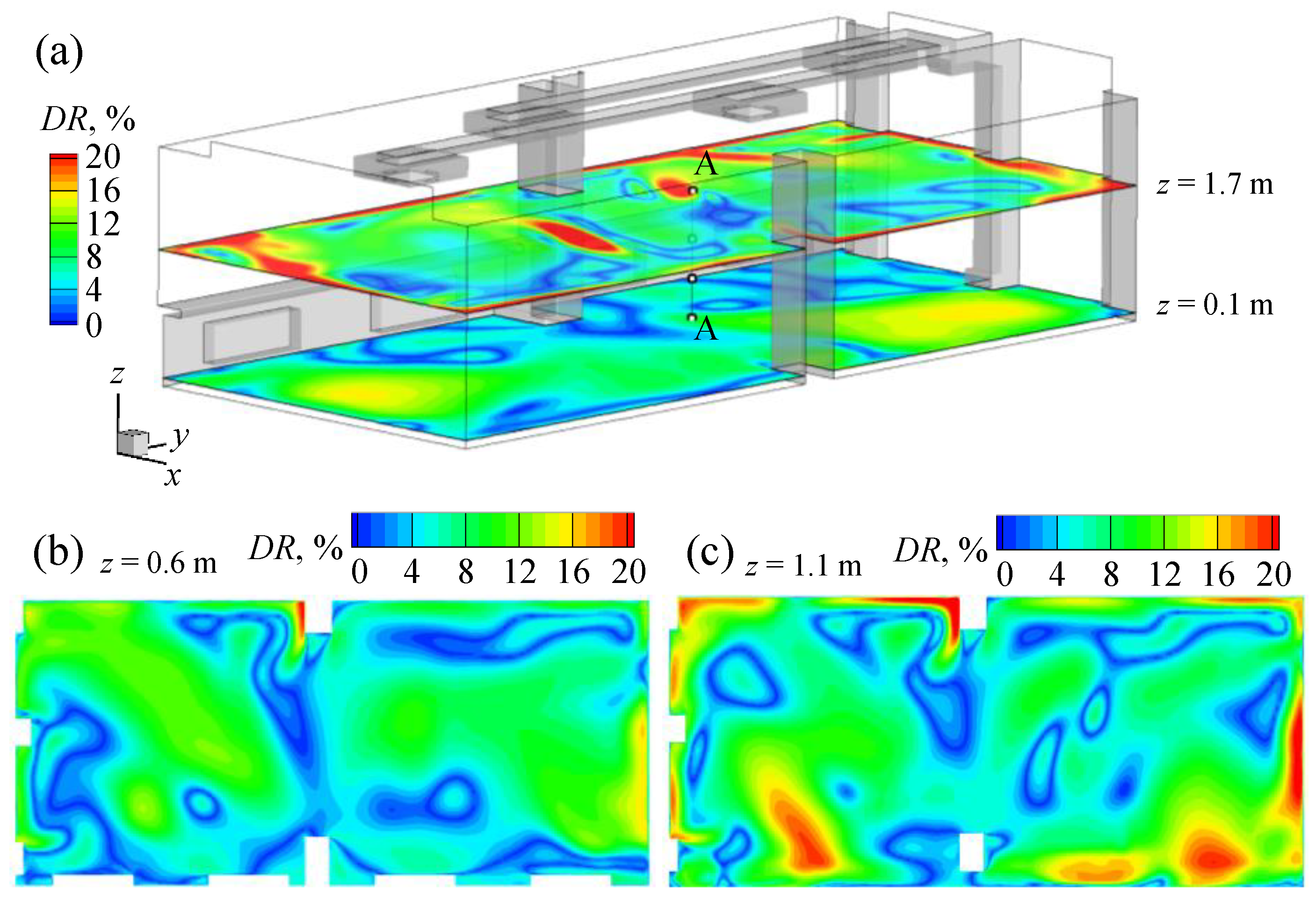
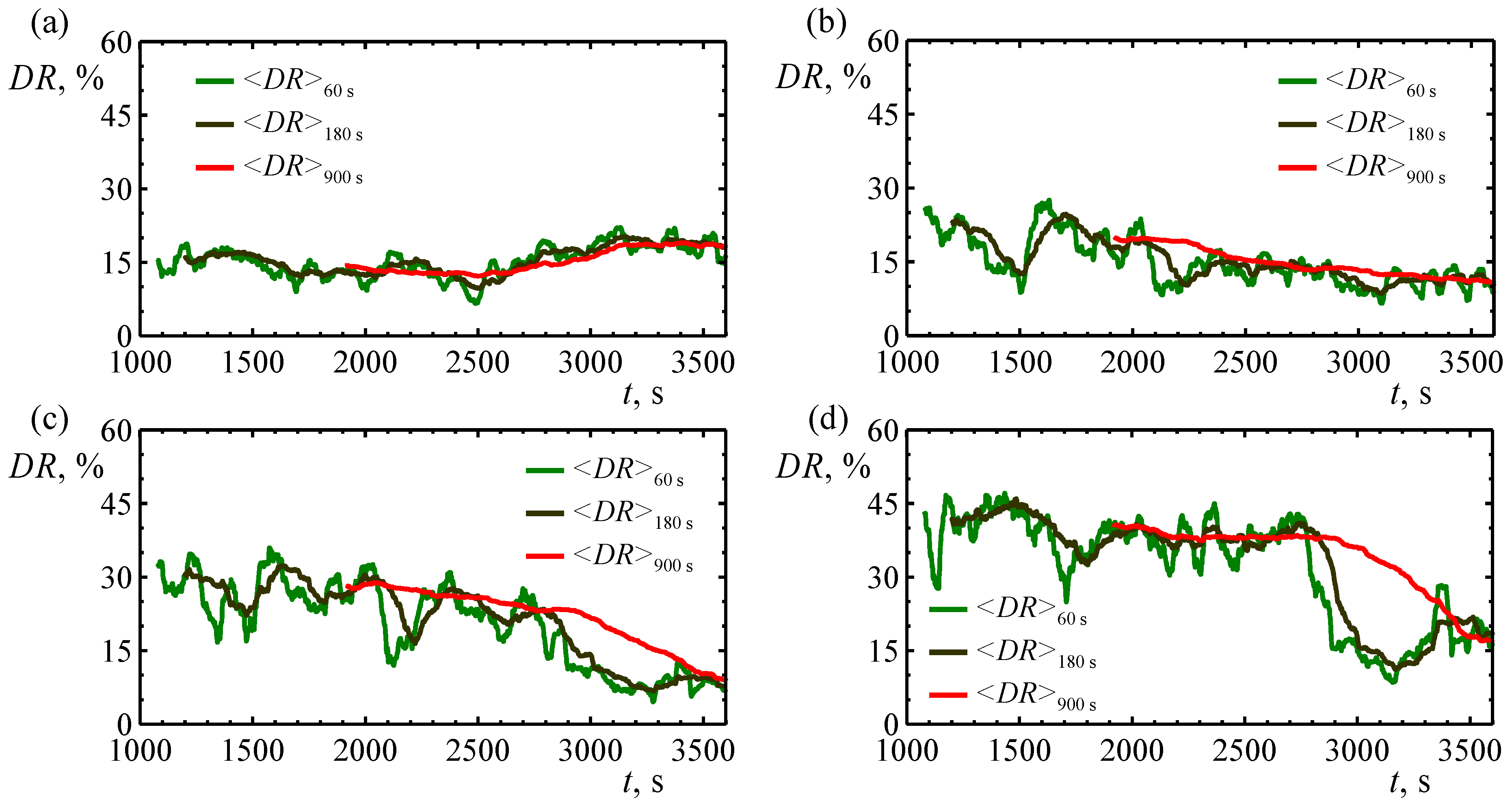


| Case | Study | θ | Cooling Mode | Time-Sample, s |
|---|---|---|---|---|
| #1 | Experimental | 25° | Nonisothermal | 3600 |
| #2 | Experimental CFD | 25° | Isothermal | 360 7500 |
| #3 | Experimental CFD | 45° | Isothermal | 300, 2100 7500 |
| Fan coil Number | East Section | South Section | West Section | North Section |
|---|---|---|---|---|
| #1 | 212 | 146 | 190 | 196 |
| #2 | 174 | 158 | 203 | 191 |
| #3 | 170 | 163 | 197 | 168 |
| #4 | 164 | 189 | 193 | 173 |
| Section | Wall | Seated Persons | Standing Person | |||||
|---|---|---|---|---|---|---|---|---|
| x = 0 | x = 5.4 m | y = 0 | y = 11.8 m | z = 0 | z = 3.2 m | |||
| q, W/m2 | 2.32 | 11.67 | 10.15 | 8.04 | 17.52 | 18.23 | 51.41 | 43.50 |
| Supply Section | Vmin, m/s | Vaver, m/s | Vmax, m/s | Vmax − Vmin, m/s |
|---|---|---|---|---|
| East | 3.73 | 3.87 | 3.99 | 0.27 |
| South | 2.86 | 3.61 | 4.13 | 1.27 |
| West | 3.34 | 4.11 | 4.52 | 1.18 |
| North | 2.65 | 3.42 | 4.46 | 1.82 |
| Outlet | <Tu>10 s, % | <Tu>30 s, % | <Tu>60 s, % | ||||||
|---|---|---|---|---|---|---|---|---|---|
| min | mean | max | min | mean | max | min | mean | max | |
| East | 0.53 | 0.81 | 1.14 | 0.68 | 0.82 | 0.98 | 0.72 | 0.83 | 0.95 |
| South | 2.80 | 4.53 | 6.04 | 3.67 | 4.59 | 5.50 | 4.01 | 4.61 | 5.18 |
| West | 1.96 | 2.99 | 4.41 | 2.43 | 3.01 | 3.64 | 2.64 | 3.02 | 3.43 |
| North | 3.78 | 5.92 | 9.12 | 4.75 | 5.99 | 7.78 | 5.13 | 6.00 | 7.05 |
© 2020 by the authors. Licensee MDPI, Basel, Switzerland. This article is an open access article distributed under the terms and conditions of the Creative Commons Attribution (CC BY) license (http://creativecommons.org/licenses/by/4.0/).
Share and Cite
Markov, D.; Ivanov, N.; Pichurov, G.; Zasimova, M.; Stankov, P.; Smirnov, E.; Simova, I.; Ris, V.; A. Angelova, R.; Velichkova, R. On the Procedure of Draught Rate Assessment in Indoor Spaces. Appl. Sci. 2020, 10, 5036. https://doi.org/10.3390/app10155036
Markov D, Ivanov N, Pichurov G, Zasimova M, Stankov P, Smirnov E, Simova I, Ris V, A. Angelova R, Velichkova R. On the Procedure of Draught Rate Assessment in Indoor Spaces. Applied Sciences. 2020; 10(15):5036. https://doi.org/10.3390/app10155036
Chicago/Turabian StyleMarkov, Detelin, Nikolay Ivanov, George Pichurov, Marina Zasimova, Peter Stankov, Evgueni Smirnov, Iskra Simova, Vladimir Ris, Radostina A. Angelova, and Rositsa Velichkova. 2020. "On the Procedure of Draught Rate Assessment in Indoor Spaces" Applied Sciences 10, no. 15: 5036. https://doi.org/10.3390/app10155036
APA StyleMarkov, D., Ivanov, N., Pichurov, G., Zasimova, M., Stankov, P., Smirnov, E., Simova, I., Ris, V., A. Angelova, R., & Velichkova, R. (2020). On the Procedure of Draught Rate Assessment in Indoor Spaces. Applied Sciences, 10(15), 5036. https://doi.org/10.3390/app10155036









